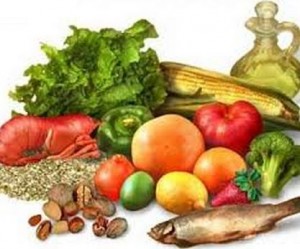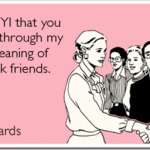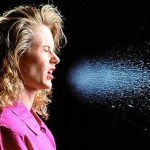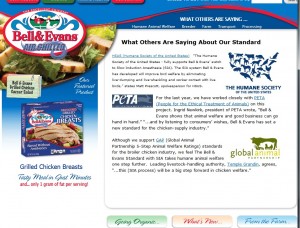More Evidence That The Mediterranean Diet Is Healthiest
We’ve known for quite some time that weight loss can reduce the risk of developing insulin resistance and type 2 diabetes. However, a healthy diet alone (without weight loss) may also help to reduce risk. In a recent Spanish study (published in the Annals of Internal Medicine), 3,541 men and women ages 55-80 at risk for diabetes were followed for an average of 4.1 years. Those who ate a diet rich in fish, whole grains, fruits, vegetables, and olive oil were…
30 Simple Things You Don’t Realize You Do That Impress Everyone Around You
One the biggest mistakes people make when they’re trying to impress someone is that they assume people only pay attention to the important or “big” things they do. But the reality is that the little things are what matter most. It’s the little things we do or don’t do every day that shape us in to who we are. The little things…
Don’t Let Your Dream Die Inside of You
By Dr. Shauntel Peak-Jimenez – If you have a dream bubbling in your heart, what are you doing to move forward? It is time for you to stop simply dreaming, and start becoming your dream. How do you become your dream? You have amazing gifts and talents that God has placed inside of you. But […]
Serenity Stewart: A Near-Death Experience Inspired Her To Chase A Dream
It took a brain aneurysm to literally knock some sense into her head, says 56-year-old contemporary jazz artist Serenity Stewart. The single mother of four was living on the working mother’s treadmill of putting in long hours at her daytime office job and then working even longer hours managing her family’s needs. Her own dream […]
How To Use Thoughts That Hold You Back
Ever had a negative thought? Then you’ll know that negative thinking can prevent you from being happy, trying new things and achieving your potential, as well as many other drawbacks. One of the most serious and life damaging effects it can have is to hold you back from doing things that you actually want to […]
Contest for bloggers, reviewers, social media gurus and extraordinary people.
Review one of the books and win an iPad and a weekend in sunny Florida! To win: Write a minimum of 250 word review on one of the books on Amazon or Goodreads.com or a blogpost. Additionally, to increase your chances: tweet, share on Facebook what you like about the book or engage on other […]
Ways to Keep Your Wits When the Children Are Unruly
Ken Myers – It can be exceptionally hard work being a parent. At times the level of frustration you feel can be almost overwhelming. For a parent with multiple children near the same age group, the complications can easily multiply. However, you need to keep your wits about you for the sake of the children. […]
I Followed My Dream
By Miriam B Medina – “Almost no goal is impossible of attainment if you can accept it as being within the realms of possibility” –Jack Addington I always loved to sing, act and dance, as far back as I can remember. Coming from a financially limited family of nine, including seven children and my parents, […]
Financial Goal Setting: How to Create a Plan to Get What You Want
James Torres – Life requires planning, and we all know how to do that. If you want to become a doctor, take a vacation or throw a dinner party, you make a plan; you figure out the steps to take and resources to use to achieve your objective. So why do so few of us […]
10 Steps To Finding A Good Doctor And Having A Great Healthcare Experience
I’m excited to announce that US News and World Report has invited me and some other social-media savvy physicians to participate in a live Twitter chat about how to find a good doctor. The chat will be held on Thursday, March 20th at 2pm EST. You can join the conversation by following the #DoctorFinder hashtag or take the pre-chat poll here.
Most people, including physicians, rely on personal references to find a good doctor. But what do you do when you’re far from home, or you don’t know anyone with firsthand knowledge of local doctors? My parents recently asked me to recommend a physician for them in a state where I knew none of my colleagues personally. This is the 10-step process that I used to help them navigate their way to an excellent specialist – I hope it helps others you find the right doctor as well!
1. Determine what kind of doctor you need. You’d be surprised how many different specialists treat the same symptom – depending on its underlying cause. Take “back pain” for example – should you see a primary care physician, an orthopedist, a neurosurgeon, an anesthesiologist, a rheumatologist, or a rehab specialist to evaluate your symptoms? That depends on the cause of the pain, which might not yet be evident to you. The first step to finding a good physician is to figure out which type is best suited to your potential diagnosis. Bouncing from specialist to specialist can be costly, so if you’re not sure which kind of physician specializes in treating your disease or condition (or if you haven’t been diagnosed yet), start with a primary care physician first.
If you’d like to ask an online physician about your symptoms (or find out which specialist would be the most appropriate for you or your loved one), eDocAmerica.com is my favorite online physician consultant service (note that I answer questions for them.)
2. Compile a list of all the doctors (of the specialty you need) in your area. This list can be generated by your insurance carrier or by an online search of doctor-finder databases such as Healthgrades.com, Vitals.com, or US News & World Report’s Doctor Finder directory.
3. Narrow online choices by your preferences (available via Healthgrades.com or Vitals.com databases.) Check out the doctors’:
4. Do an online “background check” of your top choices.
- Verify their board certification at the American Board of Medical Specialties (ABMS) –registration required.
- Check for any negative reports at their home state’s licensing website – Go to “verify a license” ( e.g. CA)
- Google them – do they have a blog or social media presence? If so, get to know them that way.
5. Make an appointment – consider the following qualities in a good physician experience:
- The team: courteousness of scheduling staff, professionalism of nurses, PA’s, techs, etc.
- Facilities – cleanliness, comfort
- Medical records/communication – how will they provide you your data? EMR? Email?
- Timeliness/convenience
6. Come prepared
- Bring your list of medications
- Bring a list of your medical and surgical history/conditions
- Bring a list of your allergies
- Bring contact information for your other physicians/providers
- Bring your insurance information
7. Ask the right questions
- How many procedures (like the one I’ll need) have you performed previously?
- What are the risks/benefits of the procedure? Alternatives?
- What should I read to learn more about this?
- If unsure of diagnosis: What else could this be?
- Are there other medicines that are less expensive that we could substitute?
8. Go with your gut
- Did the doctor explain everything clearly?
- Did the doctor seem to care about you?
- Do you trust your doctor to be thorough with follow up?
- Do you like your doctor?
9. Get a second opinion
- If the doctor did not meet your expectations in any significant way, find another one
- If you want to be sure that you’re on the best path, get a second opinion from one of his/her peers or do it online: eDocAmerica (for generalist questions), Best Doctors (to be matched with top national specialists)
10. Reward good doctors with good online recommendations so others can benefit. Physician ratings are only as reliable as the reviewers. Help other patients locate good doctors by promoting those who deserve it.
7 Reasons to Be Proud to Be Irish
By Sean M Kelly – Sometimes with all the financial scandals we are currently hearing about we lose sight of our true Spirit. Whether this is Irish, American, English, Scottish or whatever, it is important to remind ourselves of our true Spirit which is far greater than any recession and far deeper than any surface […]
The One Single Habit That Will Change Your Life
By Lyndsay Wilson – If you wanted to, you could wake up tomorrow and do something good for yourself – quit smoking, call your mom, eat something healthy for lunch. You could decide that come Monday, you’re signing up at the gym and taking up weight training, or doing an online course to improve some […]
Living Your Dream— Finally! Serenity Stewart on The Self Improvement Show
Serenity Stewart is a top jazz singer—a seasoned entertainer described as “Sultry, a little bawdy, and very talented…a stunningly talented songstress with a naughty twinkle in her eye and plenty of curves all around.” She has two successful albums and a very busy performance schedule including a recent tour in Europe. In 2005, after suffering […]
Going green (food) for St. Patrick’s Day
By Donald Bucklin – I’m half Irish, and my most memorable St. Patrick’s days were spent in college, drinking green beer for breakfast! ’Tis a shame, Guinness or Murphy’s are Irish, and are much more pleasing on the palette. They are also packed with good stuff you won’t find in the average green-dyed lager. Naturally […]
The First Person To Do Anything
‘The first person to do anything was doing the impossible’ I wish I knew who to quote on this one but I don’t. But what a powerful thought to keep in mind, at least for me. Let me explain… When I first got started on the road of entrepreneurship and personal growth, I heard a […]
Emptiness Dancing
‘I’ve got an emptiness deep inside and I try but it won’t let me go’ (Neil Diamond) Many of us are familiar with that empty feeling. It manifests as a sort of gnawing that won’t go away; a little nagging voice that either asks, “What is life all about?” or else states “There must be […]
How Changing Your Perspective Can Change Your Life
To everything in life, there’s always a negative and a positive perspective. I didn’t start getting serious with life until late 2008. But before then, I saw every bad situation as bad and every good situation as good. And I bet many of us still see things this way. Then I laid my hands on […]
How to Avoid Getting Stuck in Loneliness
Loneliness is often associated with being weak or being a loser. Most people see it as a dark, negative state. I used to think that too, until I started studying it more seriously. Here Is How To Understand It Better Imagine if you didn’t have the sensation we call “hunger.” You’d never feel the urge […]
12 of My Most Shared Facebook Posts of 2014
Well it’s been a long time since I last posted on the blog. As you know I have been extremely busy with the launch of a brand new site, with my business partners Dan and Keith. After 18 months we have finally launched GuidedMind.com which has over 100 guided meditation albums and another 100 to […]
Be Like Edison – Don’t Stop When It Looks Impossible
I recently came across a quote I’d never heard from Thomas Edison: “Nearly every man who develops an idea works at it up to the point where it looks impossible, and then gets discouraged. That’s not the place to become discouraged.” Thomas Edison, of course, is famous for having never quit when things looked impossible. […]
How to Crush Shyness and Be More Outgoing in Life
I’m not a very outgoing person by nature. Yet, I’ve found the way of the world to be rewarding and made for social and outgoing people. Outgoing people seem to have better relationships, more opportunities and be in more leadership positions. So although I feel like an introvert by nature and would rather spend hours […]
How to Win Without Being a ‘Winner’
I’m a loser! There, I said it. I’m a big loser who fails most of the time he attempts to do anything. It took me years of loneliness and rejection before I could get a girlfriend. It took me hundreds of clients before I could be sure that I was giving a good service. And […]














